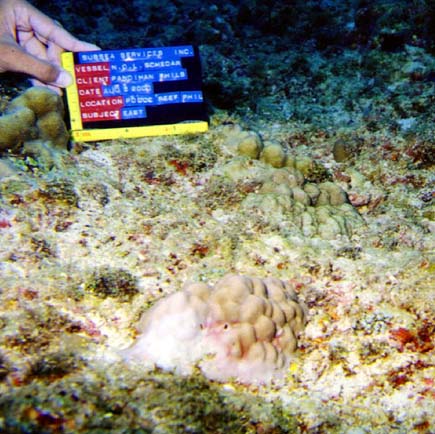|
|
Staff involved:Nick Dulvy, Nick Polunin, Rebecca MitchellFunding:NERC, Fisheries Society of the British Isles
An example of a phase-shifted reef in the Philippines. We believe the change to an algal-dominated state was induced by coral reduction (bleaching and dynamite fishing) and reduction of herbivory through fishing |
Alternate states in species diverse marine benthic communitiesProjectCommunity structure varies spatially and temporally over a variety of scales. Against this background of variability it is apparent that two or more stable alternative states may exist. A key example is coral vs. algal domination of coral reefs. One approach to understanding state changes uses a 'trophic cascade' model. Reduction in predatory control (at the top of the food web), on herbivory is believed to lead to changes in algal abundance (at the base of the food web). On hard substrates the key mediator appears to be grazing sea urchins; they can out-compete fishes due to their lower metabolic rate, and relatively few predators are capable of tackling their spiny tests. In Jamaica reduction of urchin predators and their fish competitors by fishing is argued to have led to limited control on algal abundance. When urchins were decimated by disease an algal-dominated state ensued. In Kenya, more urchin predators and fewer urchins were found inside marine reserves, reaffirming the link between fishing and trophic cascades. However, confounding factors, such as eutrophication and hurricane- and disease-induced coral mortality (Jamaica) and discontinuous fishing pressure (Kenya) have limited the generality of these case studies. To overcome the issues of eutrophication and discontinuous fishing pressure we have chosen to work in Fiji. Fiji is unique as villagers hold exclusive fishing rights and these fishing grounds (qoliqoli) have been accurately mapped. As a result Fiji offers over 400 fishing grounds of varying fishing pressure. Fishing pressure can be calculated as the number of people per unit of resource (reef front or reef area) in each fishing ground. This metric correlates well with fishing activity and yield of fish. To minimise the influence of eutrophication we have chosen to work in the distant Lau island group. This lies halfway between Fiji and Tonga and is regarded least polluted area of Fiji, with subsistence agricultural practises and almost non-existent industrialisation. An added bonus is that fishing practices tend to be non-destructive. We have selected 13 fishing grounds that constitute a gradient of fishing pressure varying from 1-60 people per km of fringing reef. SignificanceTo determine whether reef community structure varies along a gradient of fishing pressure, and whether differences are continuous or step-wise and discontinuous. To determine whether reduction in predator abundance (trophic cascades) can cause changes in algal abundance in the absence of eutrophication and coral mortality. Future directionsWe are examining the local roles of recruitment, habitat structure and predation in determining urchin abundance, and aim to measure determinants of urchin abundance at larger scales, along gradients of fishing pressure. Ultimately we aim to use the unique Fijian tenure system to examine the relative role of fishing (top-down control) and eutrophication (bottom-up control) in controlling algal abundance on coral reefs. References
|
